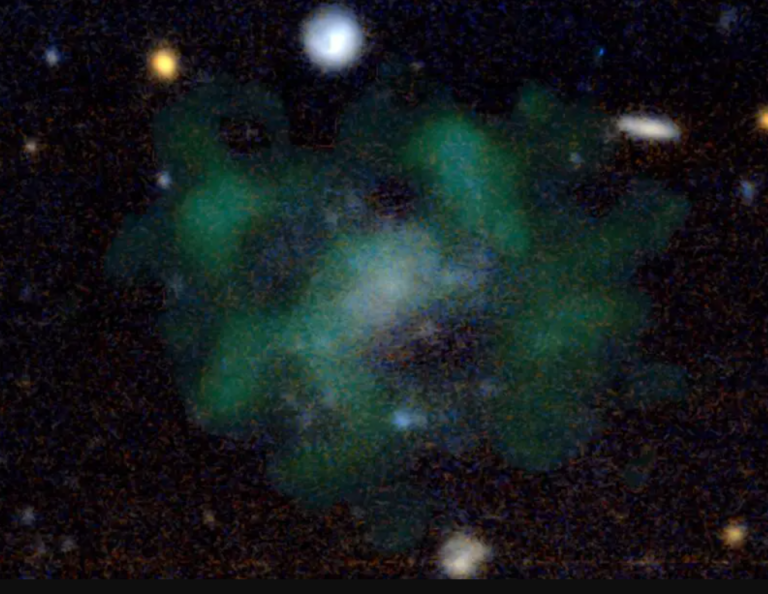Filippo Fraternali and his research team have discovered six enigmatic galaxies that resemble vast cities of stars and gas. These galaxies, unlike most others, do not seem to be surrounded by significant amounts of dark matter, which is typically responsible for their gravitational pull. By focusing on one of these galaxies located approximately 250,000 light-years away, the team utilized the 27 radio telescope antennas of the Very Large Array in New Mexico to conduct a thorough investigation.
After collecting data for a total of 40 hours, they were able to map out the distribution of stars and gas, ultimately confirming their initial suspicions. Fraternali, an astronomer at the Kapteyn Astronomical Institute of the University of Groningen in the Netherlands, noted that “The amount of dark matter that we have estimated in this galaxy is significantly lower than what would be expected.”
Fraternali’s team, as well as other researchers, may potentially uncover more galaxies similar to this, which could potentially challenge the current understanding of dark matter that has dominated the field for over two decades. The findings of Fraternali’s team were recently published in the Monthly Notices of the Royal Astronomical Society.
For years, scientists have considered dark matter as the fundamental structure of the universe, with invisible clumps of particles acting as its “joints” and hosting galaxies of various sizes. However, Fraternali’s discovery is not the first instance that deviates from this established pattern.
A few years ago, Pieter van Dokkum and his team at Yale identified similar galaxies that lacked dark matter using the Hubble telescope. Van Dokkum explains, “These galaxies that we found in 2018 generated a lot of controversy and discussion, as well as subsequent research, because they were unexpected and difficult to explain.”
While those galaxies were located in densely populated regions where neighboring galaxies could potentially strip away dark matter, Fraternali’s galaxy appears to be relatively isolated. The absence of dark matter in this case presents a significant puzzle: “How can stars and gas come together in that location without the assistance of dark matter?” wonders van Dokkum.
Known as “ultra-diffuse galaxies,” these anomalies defy conventional understanding. Despite their immense size, their mass is incredibly small, with some being as large as the Milky Way but containing only a fraction of its stars.
Their transparency makes them challenging to detect in the night sky. Mireia Montes, an astronomer at the Space Telescope Science Institute in Baltimore, explains, “They are slightly fainter in the center, making them difficult to detect. However, with the advancements in telescopes and deeper observations, they have become more widely recognized.”
In the 1960s, Vera Rubin and her colleagues deduced the presence of dark matter by examining the rotational speeds of stars in galaxies. This discovery highlighted the need for additional mass to sustain their orbital movements beyond what visible matter could provide. Dark matter, which does not emit or reflect light, was proposed as a solution to this discrepancy.
Nonetheless, Fraternali’s research indicates that dark matter may not be essential for ultra-diffuse galaxies. The observed rotation rates correspond to the combined mass of stars and gas clouds, eliminating the necessity for unseen mass. Montes and her team aim to delve deeper into these galaxies, particularly their outer regions, to identify any undetected material. Nevertheless, the mystery surrounding these ethereal galaxies endures.
Fraternali underscores a critical aspect of their galaxy, AGC 114905: its inclination. Unlike galaxies with a disc-like shape that offer a straightforward edge-on perspective, AGC 114905 is tilted at an angle exceeding 30 degrees, requiring adjustments in mass calculations. Inaccurate estimations could introduce room for dark matter.
Assuming the accuracy of the team’s computations, the true nature of this extraordinary galaxy remains uncertain. Is it an enigmatic cosmic anomaly or a harbinger of challenges to prevailing dark matter theories?
Thus far, AGC 114905 challenges current explanations for the emergence of ultra-diffuse galaxies. Theories range from gravitational interactions between ancient galaxies to remnants of stellar explosions. However, none of these hypotheses adequately explain the unique characteristics of AGC 114905.
Indeed, AGC 114905 appears to contradict models that incorporate dark matter. Despite numerous simulations over the years, no existing model can replicate the distinct features of this galaxy.
Fraternali’s findings and similar ones point to the necessity for different interpretations of dark matter. These departures from expected behaviors could signify a fundamental misconception of gravitational physics.
One promising option among the proposed alternatives is Modified Newtonian Dynamics (MOND). By modifying Newton’s law of gravity, MOND aims to address inconsistencies in galactic rotational velocities without relying on dark matter. Nevertheless, it falls short in elucidating galaxies such as AGC 114905.
The impact of AGC 114905 on dark matter hypotheses remains ambiguous. Fraternali and his colleagues will persist in analyzing these mysterious galaxies, supported by sophisticated instruments like the James Webb Space Telescope, in the quest for solutions. “We’re not exploring the universe’s boundaries or attempting to spot a small planet near a star. It’s feasible with the current tools at our disposal,” van Dokkum notes, emphasizing the enthusiasm surrounding this ongoing investigation.
Do not forget to share your opinion with us to provide you with the best posts !




0 Comments